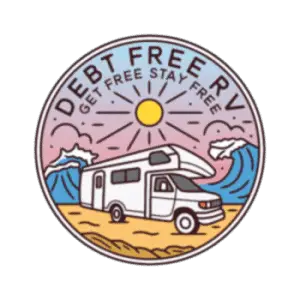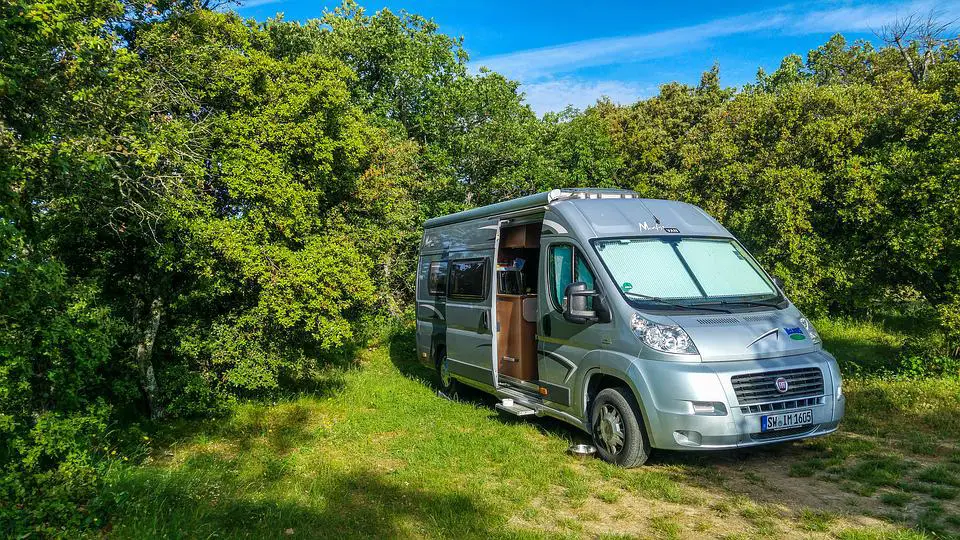On average, Americans spend most of their money on the “Big Three”: Housing (33%), transportation (16%), and food (13%). With nearly one-third of earnings going toward high rent or mortgage payments, many people are starting to wonder if there’s a more thrifty way to live, and are asking the question: “Can you live in an RV to save money?”
Living in an RV can save you hundreds (or thousands) of dollars every month! Compared to paying rent, RVing is- generally- a cheaper way to live; However it does come with it’s own unique expenses.
For those new to RVing, here are some of the additional costs that you’ll need to take into consideration…
Rent Free… But Where Will You Sleep?

Giving up your sticks-and-bricks for an RV will get rid of monthly rent payments, but not all RVing is free. It’s important to know where you’ll be living in your RV and where you’ll park for a bit of shut eye.
There are a number of options:
- Boondocking (off-grid, city street camping) = $0
- Family + Friend’s Property = $0 – $__?
- BLM Campground Land = $10/night and up
- RV Resorts + Pay Campsites = Price varies
Boondocking, or “dry camping” is just another way of saying off-grid, living without hookups and no rent. If you’re looking to save some major money, this may be a good option.
Having the ability to park on family or friends’ land or driveway may not be an option for everyone, but if it is for you, you may be able to live there rent free, trade work for a place to park, or negotiate on low monthly “rent” for use of their property.
BLM (Bureau of Land Management) Land is another option; One that’s popular among senior citizens dependent on Social Security due to the cheap costs of living on the land. Costs to park in BLM land vary from $10 to over $100 for nightly camping.
RV Parks and Campsites are also options to live full time in an RV, however, that’s trading one rent expense for another. While RV parks often cost less than traditional apartments and mortgages, that’s not true across the board…
In southern California, for example, RV parks can cost over $60/night, or over $1,800 for monthly stays. If you’re living in an RV to save money, this may not be the best option.
Dump Station Costs
For those new to RVing, taking care of your own waste is a new experience. So is being charged to do so!
In an RV, toilets are connected to what’s referred to as a black tank. When you flush the toilet, a black tank is where everything is stored until making a visit to a dump station.
RVs also have two other tanks: One for fresh water (showers, sinks, toilet flushing, etc.), and a grey tank (where the dirty water is stored once it makes it’s journey down the drain after using the shower or sink).
If you’re not living in a campsite or RV park that provides black tank hookups, then you’ll need to make a trip to a dump station whenever your tanks get full, and typically, dump stations charge for the convenience.
Normally, dump stations will charge only a few dollars, between $5 – $15 for a “dump” (and refilling a fresh water tank is typically free). Going to a dump station will be a recurring cost while living in an RV, so make sure to factor in this expense when determining the cost of RV life.
Before my husband and I removed our RV’s toilet and replaced it with a Thetford Porta Potti, we would dump our tanks once every three weeks. Our black water holding tank was 40 gallons (standard sizes for RVs are between 20 to 40 gallons), with just the two of us using it. So, we would fill 40 gallons of waste every three weeks, each time costing $15 per dump.
And since we’re on the topic of toilets, there are a few more toiletry items needed for RVing, that will be new expenses to consider…
RV Toiletry Costs
Chemical Treatment
RV toilets are similar to those in traditional homes, with a few important exceptions. First, in order to break down waste in the black tank, chemicals are needed. These chemicals not only break down solid waste- making dumping much easier- but they also help control the smell in between dumps.
These chemicals are referred to as holding tank treatment and come in powder, liquid or pod-form.
The cost for treatments depends on the type, and how much you’re purchasing. Take a look at the wide variety available- and their associated costs, here on Amazon.
Personally, we’ve tried each type: Liquid, powder and pods, and have continued using the pre-measured pods. These are the easiest, as there’s no thinking involved: Just throw a pod and some water in the dump tank and let it work it’s magic until Dump Day!
We purchase our Porta-Pak pods from our local dump station, costing $10 for a pack of 10 = $1 per dump.
Directions for the amount of chemical treatment is found on the bag, with the quantity needed depending on the size of your black holding tank.
For us, dump our portable toilet once every three days, so we use approximately 10 pods per month, costing $10 per month.
RV Toilet Paper
One last expense to take into account is RV/marine toilet paper. Unlike traditional toilets, RV’s require quick-dissolving toilet paper, so the pipes don’t get clogged up. Using regular paper is a definite “no-no” in an RV.
RV/marine fast-dissolving “TP” can be found on Amazon, Walmart, Camping World, and often at dump stations themselves. The average cost for a pack of four is $6.
Hot Spot Costs
If you want internet access on the road, you’ll need to invest in a mobile Hot Spot.
For us, our Alcatel hot spot has been a life saver and it’s monthly rental fee of $10 is embedded in our phone service bill.
This small device is easily stored and charged, allowing us have access to the internet wherever we go.
The only downside is that streaming videos eats up the data very quickly, so we’ll eventually invest in an Unlimited Hot Spot plan.
Free WiFi is another option for RVers; Fast food restaurants and coffee shops normally have free WiFi available for use.
But that means you need to be close enough to one of these establishments in order to have access.
Personally, we don’t think it’s the best option as RVers need to remain tethered to a Mc Donald’s or Starbucks, but it’s good to know this is another (free) option when needed.
Propane Costs
Propane is a gas used for your RV’s cooktop, oven, and heaters. It’s a cheap way to power these appliances, with a 20 lb tank costing approximately $20 to fill.
In our case, it takes a few months until we need a refill; propane is an incredibly cost effective resource.
Refilling tanks is as easy as going to a gas station or dump station and asking the attendant to fill up your tank.
Cost of Repairs and General Maintenance

Repairs and general maintenance are a must for any vehicle and it’s especially necessary if your vehicle is also your home!
Getting regular oil changes will keep your home on wheels running well, but there are also repairs and maintenance that will come up on the road…
Battery needs replacing? $200. Bi-annual smog test? $180. Roof repair? $2,800. (Hopefully, you won’t have such an expensive, leaky roof problem like us, but this demonstrates just how important consistent maintenance is!)
As RVs are driven, everything bounces and jiggles around; that means things become loose, come apart and need some TLC.
There’s also roof and generator maintenance, window caulking, and tire care.
Some repairs are a major expense, but you can keep costs lower by continuously maintaining your RV.
Comparing Costs: Our Monthly Expenses
Now that you have a sense of the expenses associated with RVing, I’m going to show you the monthly expenses my husband and I currently have. Hopefully this “real world” example can help you decide if RV living will help you save money:
- Summer Savings = $700*
- Emergency Fund = $600**
- Phones + Mobile Hot Spot = $200
- Groceries = $600
- Insurance = $125
- Gas = $200
- Online Biz = $12
- Cat = $20
- Spotify = $10
- Friend’s Art Patreon Subscription = $12
- Nephew’s Saving Account = $100
- Netflix = $13
- Voice Lessons = $250
- RV / Incedentals = $50 – $150
- TOTAL Costs = $3,000 / month
Without saving for Summer (I work in the school system and have no income during the months of June, July, and part of August), and without putting away money in our Emergency Fund, our monthly expenses go down to just $1700-$2100 a month!
In order to determine if living in an RV will help you save money, do a “Self-Audit”; Make a list of all your current expenses, including rent, student loans, credit cars, groceries, etc.. Then, make another list of what your monthly expenses might look like if you were living full-time in an RV. You might be surprised at how much money you can save living on the road!
Wrap Up
Living in an RV to save money is absolutely possible. Although there are some added expenses unique to RVing, by saving money on rent, RVers have more of an opportunity to save and pay off debt.
So, if you’re thinking of joining the caravan, check out “What Kind of RV Should I Buy”, here!



